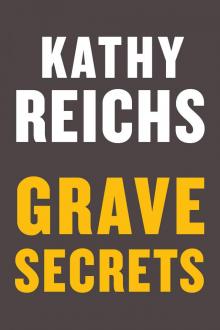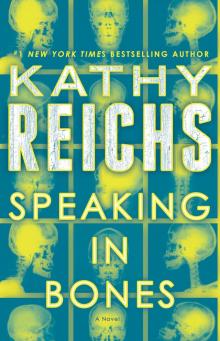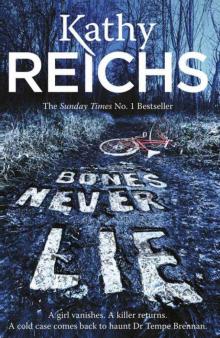- Home
- Kathy Reichs
Fatal Voyage
Fatal Voyage Read online
“Fans of TV’s CSI: Crime Scene Investigation should be in heaven” (People) stepping into the world of forensic anthropologist Dr. Temperance Brennan, star of Kathy Reichs’ electrifyingly authentic bestsellers.
She has a passion for the truth . . . and this time, it’s taking her down.
A commercial airliner disaster has brought Tempe Brennan to the North Carolina mountains as a member of the investigative agency DMORT. As bomb theories abound, Tempe soon discovers a jarring piece of evidence that raises dangerous questions—and gets her thrown from the DMORT team. Relentless in her pursuit of its significance, Tempe uncovers a shocking, multilayered tale of deceit and depravity as she probes her way into frightening territory—where someone wants her stopped in her tracks.
“THE PLOT MOVES WITH ELECTRIC FORCE.”
—Publishers Weekly
“REICHS IS AT THE TOP OF HER GAME. . . .”
—Booklist (starred review)
“BUCKLE UP AND TAKE THIS VOYAGE.”
—People
Includes an excerpt from Bones to Ashes—coming soon in hardcover from Scribner!
Register online at www.SimonandSchuster.com for more information on this and other great books.
AUTHOR PHOTOGRAPH BY MARIE-REINE MATTERA
ABOUT THE AUTHOR
KATHY REICHS, like her fictional creation Temperance Brennan, is a board-certified forensic anthropologist for the Laboratoire de Sciences Judiciaires et de Médecine Légale for the province of Quebec, a position she also held at the Office of the Chief Medical Examiner, State of North Carolina. She is Vice President of the American Academy of Forensic Sciences and serves on the National Police Services Advisory Council in Canada. A professor of anthropology at the University of North Carolina at Charlotte, Dr. Reichs received her Ph.D. at Northwestern University. She now divides her time between Charlotte and Montreal. Her debut novel, Déjà Dead, brought her fame when it became a New York Times bestseller, a #1 international bestseller, and winner of the 1997 Ellis Award for Best First Novel. Bones to Ashes, her tenth Temperance Brennan novel, is forthcoming in hardcover from Scribner.
Her website is www.kathyreichs.com.
CRITICAL RAVES FOR NEW YORK TIMES BESTSELLING AUTHOR
KATHY REICHS
and her powerful thrillers featuring her fictional counterpart, forensic anthropologist Dr. Temperance Brennan
FATAL VOYAGE
NEW YORK TIMES BESTSELLER
“Reichs proves once again that she is master of the genre; her science is impeccable, her characters are believably complex, and her plotting and pacing are nearly flawless.”
—Library Journal (starred review)
“Like Patricia Cornwell, Reichs is expert at autopsy protocol and the intricacies of the death sciences.”
—Kirkus Reviews
“Morbid yet captivating. . . . It is Reichs’s ongoing development of Tempe—a woman in her fifties with a mature understanding of human nature and a self-deprecating sense of humor—that truly lifts the book above many of its peers.”
—Publishers Weekly
“A complicated, involving mystery.”
—Booklist (starred review)
“A clever job.”
—The New York Times Book Review
DEADLY DÉCISIONS
#1 INTERNATIONAL BESTSELLER
“Kathy Reichs is in a class all by herself. She knows more about forensic anthropology and building intricate suspense than any other author I’ve found in a decade. Her research isn’t the obvious research of many mystery writers: quite clearly, Reichs has been there herself. That makes the difference between light reading and a classic. Amazing!”
—Ann Rule, New York Times bestselling author of Empty Promises
“Bloody good beach reading!”
—USA Today
“Pleasingly intricate. . . . The tart, bilingual dialogue is first-rate.”
—The Sunday Times (London)
“Moves along like a Harley-Davidson leading the pack in an outlaw road race. . . . Reminiscent of Patricia Cornwell at the top of her game.”
—The San Francisco Examiner
“A good, fast, scary read—a page-turner.”
—The Gazette (Montreal)
“Tempe Brennan [is] curious and sharp, blessed with a passion for the truth and cursed with a disregard of danger.”
—St. Louis Post-Dispatch
“This is a mystery for the intelligent mystery fan. . . . Reichs has brought the detective story into the twenty-first century.”
—The Toronto Sun
DEATH DU JOUR
#1 INTERNATIONAL BESTSELLER
“A delectable tale of corpus delicti. . . . Atmospheric, suspensefully paced. . . . Likely to leave you with the shivers. . . . bone-chilling prime crime.”
—People
“The writing is snappy, and the forensic detail gruesome—and riveting.”
—Entertainment Weekly
“A nerve-tingling, bullets-are-flying showdown. Brennan is a winner, and so is Reichs.”
—Daily News (New York)
DÉJÀ DEAD
#1 INTERNATIONAL BESTSELLER WINNER OF THE CRIME WRITERS OF CANADA’S ARTHUR ELLIS AWARD FOR BEST FIRST NOVEL
“Déjà Dead can lie side-by-side with the works of Patricia Cornwell. . . . Both do a fine job of telling a good, sometimes scary tale.”
—The Washington Times
“It’s mesmerizing to watch as Temperance slices, measures, and weighs. . . . We can rely on her clinical detachment and female concern.”
—San Francisco Chronicle
“Great, suspenseful fun. . . . Temperance Brennan is the real thing.”
—New York Newsday
“The dialogue crackles with Tempe’s black humor.”
—Maclean’s (Toronto)
“As good as Cornwell at her best.”
—Detroit Free Press
BOOKS BY KATHY REICHS
Déjà Dead
Death Du Jour
Deadly Décisions
Fatal Voyage
Thank you for purchasing this Pocket Star Books eBook.
Sign up for our newsletter and receive special offers, access to bonus content, and info on the latest new releases and other great eBooks from Pocket Star Books and Simon & Schuster.
or visit us online to sign up at
eBookNews.SimonandSchuster.com
This book is a work of fiction. Names, characters, places and incidents are products of the author’s imagination or are used fictitiously. Any resemblance to actual events or locales or persons living or dead is entirely coincidental.
A Pocket Star Book published by
POCKET BOOKS, a division of Simon & Schuster, Inc.
1230 Avenue of the Americas, New York, NY 10020
www.SimonandSchuster.com
Copyright © 2001 by Temperance Brennan, L.P.
Originally published in hardcover in 2001 by Scribner
All rights reserved, including the right to reproduce this book or portions thereof in any form whatsoever. For information address Scribner, 1230 Avenue of the Americas, New York, NY 10020
ISBN: 0-671-02837-5
ISBN 13: 978-0-7432-1822-1 (ebook)
First Pocket Books printing July 2002
POCKET STAR BOOKS and colophon are registered trademarks of Simon & Schuster, Inc.
Tip-in illustration by Don Brautigam
Dedicated with button-bursting pride to:
Kerry Elisabeth Reichs, J.D., M.P.P., Duke University, Class of 2000
Courtney Anne Reichs, B.A., University of Georgia, Class of 2000
Brendan Christopher Reichs, B.A. (cum laude), Wake Forest University, Class of 2000
Yippee!!!
CONTENTS
Acknowledgments
Chapter 1
Chapter 2
Chapter 3
Chapter 4
Chapter 5
Chapter 6
Chapter 7
Chapter 8
Chapter 9
Chapter 10
Chapter 11
Chapter 12
Chapter 13
Chapter 14
Chapter 15
Chapter 16
Chapter 17
Chapter 18
Chapter 19
Chapter 20
Chapter 21
Chapter 22
Chapter 23
Chapter 24
Chapter 25
Chapter 26
Chapter 27
Chapter 28
Chapter 29
Chapter 30
Chapter 31
Chapter 32
Chapter 33
Chapter 34
Afterword
‘Grave Secrets’ Teaser
ACKNOWLEDGMENTS
As always, I owe many thanks to many people:
To Ira J. Rimson, P.E., and Captain John Gallagher (retired), for input on aircraft design and accident investigation. To Hughes Cicoine, C.F.E.I., for advice on fire and explosion investigation. Your patience was amazing.
To Paul Sledzik, M.S., National Museum of Health and Medicine, Armed Forces Institute of Pathology, on the history, structure, and operation of the DMORT system; Frank A. Ciaccio, M.P.A., Office of Government, Public, and Family Affairs, United States National Transportation Safety Board, for information on DMORT, the NTSB, and the Family Assistance Plan.
To Arpad Vass, Ph.D., Research Scientist, Oak Ridge National Laboratories, for a crash course on volatile fatty acids.
To Special Agent Jim Corcoran, Federal Bureau of Investigation, Charlotte Division, for outlining the workings of the FBI in North Carolina; Detective Ross Trudel (retired), Communauté Urbaine de Montréal Police, for information on explosives and their regulation; Sergent-détective Stephen Rudman (retired), Communauté Urbaine de Montréal Police, for details on police funerals.
To Janet Levy, Ph.D., University of North Carolina-Charlotte, for specifics on the North Carolina Department of Cultural Resources, and answers to questions archaeological; Rachel Bonney, Ph.D., University of North Carolina-Charlotte, and Barry Hipps, Cherokee Historical Association, for knowledge about the Cherokee.
To John Butts, M.D., Chief Medical Examiner, State of North Carolina; Michael Sullivan, M.D., Mecklenburg County Medical Examiner; and Roger Thompson, Director, Charlotte-Mecklenburg Police Department Crime Laboratory.
To Marilyn Steely, M.A., for pointing me to the Hell Fire Club; Jack C. Morgan Jr., M.A.I., C.R.E., for enlightening me on property deeds, maps, and tax records; Irene Bacznsky, for help with airline names.
To Anne Fletcher, for accompanying me on our Smoky Mountain adventure.
A special thanks to the people of Bryson City, North Carolina, including Faye Bumgarner, Beverly Means, and Donna Rowland at the Bryson City library; Ruth Anne Sitton and Bess Ledford at the Swain County Tax and Land Records Office; Linda Cable, Swain County Administrator; Susan Cutshaw and Dick Schaddelee at the Swain County Chamber of Commerce; Monica Brown, Marty Martin, and Misty Brooks at the Fryemont Inn; and, especially, Chief Deputy Jackie Fortner, Swain County Sheriff’s Department.
Merci to M. Yves St. Marie, Dr. André Lauzon, and to all my colleagues at the Laboratoire de Sciences Judiciaires et de Médecine Légale; Chancellor James Woodward at the University of North Carolina-Charlotte. Your continued support is greatly appreciated.
To Paul Reichs, for his valuable comments on the manuscript.
To my superb editors, Susanne Kirk and Lynne Drew.
And, of course, to my miracle-worker agent, Jennifer Rudolph Walsh.
My stories could not be what they are without the help of friends and colleagues. I thank them. As always, all mistakes are of my making.
1
I STARED AT THE WOMAN FLYING THROUGH THE TREES. Her head was forward, chin raised, arms flung backward like the tiny chrome goddess on the hood of a Rolls-Royce. But the tree lady was naked, and her body ended at the waist. Blood-coated leaves and branches imprisoned her lifeless torso.
Lowering my eyes, I looked around. Except for the narrow gravel road on which I was parked, there was nothing but dense forest. The trees were mostly pine, the few hardwoods like wreaths marking the death of summer, their foliage every shade of red, orange, and yellow.
Though it was hot in Charlotte, at this elevation the early October weather was pleasant. But it would soon grow cool. I took a windbreaker from the backseat, stood still, and listened.
Birdsong. Wind. The scurrying of a small animal. Then, in the distance, one man calling to another. A muffled response.
Tying the jacket around my waist, I locked the car and set off toward the voices, my feet swishing through dead leaves and pine needles.
Ten yards into the woods I passed a seated figure leaning against a mossy stone, knees flexed to his chest, laptop computer at his side. He was missing both arms, and a small china pitcher protruded from his left temple.
On the computer lay a face, teeth laced with orthodontic wiring, one brow pierced by a delicate gold ring. The eyes were open, the pupils dilated, giving the face an expression of alarm. I felt a tremor beneath my tongue, and quickly moved on.
Within yards I saw a leg, the foot still bound in its hiking boot. The limb had been torn off at the hip, and I wondered if it belonged to the Rolls-Royce torso.
Beyond the leg, two men rested side by side, seat belts fastened, necks mushrooming into red blossoms. One man sat with legs crossed, as if reading a magazine.
I picked my way deeper into the forest, now and then hearing disconnected shouts, carried to me at the wind’s whim. Brushing back branches and climbing over rocks and fallen logs, I continued on.
Luggage and pieces of metal lay among the trees. Most suitcases had burst, spewing their contents in random patterns. Clothing, curling irons, and electric shavers were jumbled with containers of hand lotion, shampoo, aftershave, and perfume. One small carry-on had disgorged hundreds of pilfered hotel toiletries. The smell of drugstore products and airplane fuel mingled with the scent of pine and mountain air. And from far off, a hint of smoke.
I was moving through a steep-walled gully whose thick canopy allowed only mottled sunlight to reach the ground. It was cool in the shadows, but sweat dampened my hairline and glued my clothing to my skin. I caught my foot on a backpack and went hurtling forward, tearing my sleeve on a jagged bough truncated by falling debris.
I lay a moment, hands trembling, breath coming in ragged gulps. Though I’d trained myself to hide emotion, I could feel despair rising in me. So much death. Dear God, how many would there be?
Closing my eyes, I centered myself mentally, then pushed to my feet.
Aeons later, I stepped over a rotting log, circled a stand of rhododendron, and, seeming no closer to the distant voices, stopped to get my bearings. The muted wail of a siren told me the rescue operation was gathering somewhere over a ridge to the east.
Way to get directions, Brennan.
But there hadn’t been time to ask questions. First responders to airline crashes or other disasters are usually well intentioned, but woefully ill-prepared to deal with mass fatalities. I’d been on my way from Charlotte to Knoxville, nearing the state line, when I’d been asked to get to the scene as quickly as possible. Doubling back on I-40, I’d cut south toward Waynesville, then west through Bryson City, a North Carolina hamlet approximately 175 miles west of Charlotte, 50 miles east of Tennessee, and 50 miles north of Georgia. I’d followed county blacktop to the point where state maintenance ended, then proceeded on gravel to a Forest Service road that snaked up the mountain.
Though the instructions I’d been given had been accurate, I suspected there was a better route, perhaps a small logging trail that allowed a closer approach to the adjacent valley.
I debated returning to the car, decided to press on. Perhaps those already at the site had trekked overland, as I was doing. The Forest Service road had looked like it was going nowhere beyond where I’d left the car.
After an exhausting uphill scramble, I grabbed the trunk of a Douglas fir, planted one foot, and heaved myself onto a ridge. Straightening, I stared into the button eyes of Raggedy Ann. The doll was dangling upside down, her dress entangled in the fir’s lower branches.
An image of my daughter’s Raggedy flashed to mind, and I reached out.
Stop!
I lowered my arm, knowing that every item must be mapped and recorded before removal. Only then could someone claim the sad memento.
From my position on the ridge I had a clear view of what was probably the main crash site. I could see an engine, half buried in dirt and debris, and what looked like pieces of wing flap. A portion of fuselage lay with the bottom peeled back, like a diagram in an instructional manual for model planes. Through the windows I could see seats, some occupied, most empty.
Wreckage and body parts covered the landscape like refuse discarded at a dump. From where I stood, the skin-covered body portions looked starkly pale against the backdrop of forest floor, viscera, and airplane parts. Articles dangled from trees or lay snarled in the leaves and branches. Fabric. Wiring. Sheet metal. Insulation. Molded plastic.
The locals had arrived and were securing the site and checking for survivors. Figures searched among the trees, others stretched tape around the perimeter of the debris field. They wore yellow jackets with Swain County Sheriff’s Department printed on the back. Still others just wandered or stood in clumps, smoking, talking, or staring aimlessly.
Way off through the trees I noticed the flashing of red, blue, and yellow lights, marking the location of the access route I’d failed to find. In my mind I saw the police cruisers, fire engines, rescue trucks, ambulances, and vehicles of citizen volunteers that would clog that road by tomorrow morning.
The wind shifted and the smell of smoke grew stronger. I turned and saw a thin, black plume curling upward just beyond the next ridge. My stomach tightened, for I was close enough now to detect another odor mingling with the sharp, acrid scent.

 Two Nights
Two Nights The Bone Collection: Four Novellas
The Bone Collection: Four Novellas Fatal Voyage
Fatal Voyage 206 Bones
206 Bones Bones to Ashes
Bones to Ashes Terminal
Terminal Monday Mourning
Monday Mourning Flash and Bones
Flash and Bones Cross Bones
Cross Bones Devil Bones
Devil Bones Break No Bones
Break No Bones Swamp Bones
Swamp Bones Déjà Dead
Déjà Dead Shock
Shock Spider Bones
Spider Bones Death Du Jour
Death Du Jour Grave Secrets
Grave Secrets Trace Evidence: A Virals Short Story Collection
Trace Evidence: A Virals Short Story Collection Bones on Ice
Bones on Ice The Bone Code
The Bone Code Bones in Her Pocket
Bones in Her Pocket Seizure:
Seizure: Speaking in Bones
Speaking in Bones Deadly Decisions
Deadly Decisions Spike
Spike Bones Never Lie
Bones Never Lie Bones of the Lost
Bones of the Lost Virals 03.5 - Swipe
Virals 03.5 - Swipe Exposure
Exposure A Conspiracy of Bones
A Conspiracy of Bones Shift (tory brennan)
Shift (tory brennan) Bones of the Lost: A Temperance Brennan Novel tb-16
Bones of the Lost: A Temperance Brennan Novel tb-16 Virals tb-1
Virals tb-1 Bones Are Forever tb-15
Bones Are Forever tb-15 Code tb-3
Code tb-3 Seizure tb-2
Seizure tb-2 Deadly Descisions
Deadly Descisions Spider Bones: A Novel
Spider Bones: A Novel